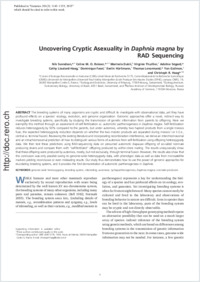Uncovering cryptic asexuality in Daphnia magna by RAD sequencing
- Svendsen, Nils Centre d’Ecologie Fonctionnelle et Evolutive (CEFE)–Unité Mixte de Recherche 5175, Centre National de la Recherche Scientifique (CNRS)–Université de Montpellier, Montpellier, France
- Reisser, Céline M. O. Centre d’Ecologie Fonctionnelle et Evolutive (CEFE)–Unité Mixte de Recherche 5175, Centre National de la Recherche Scientifique (CNRS)–Université de Montpellier, Montpellier, France - Ecology and Evolution, University of Fribourg, Switzerland
- Dukić, Marinela Zoology Institute, Evolutionary Biology, University of Basel, Switzerland
- Thuillier, Virginie Ecology and Evolution, University of Fribourg, Switzerland
- Ségard, Adeline Centre d’Ecologie Fonctionnelle et Evolutive (CEFE)–Unité Mixte de Recherche 5175, Centre National de la Recherche Scientifique (CNRS)–Université de Montpellier, Montpellier, France
- Liautard-Haag, Cathy Ecology and Evolution, University of Fribourg, Switzerland
- Fasel, Dominique Ecology and Evolution, University of Fribourg, Switzerland
- Hürlimann, Evelin Ecology and Evolution, University of Fribourg, Switzerland
- Lenormand, Thomas Centre d’Ecologie Fonctionnelle et Evolutive (CEFE)–Unité Mixte de Recherche 5175, Centre National de la Recherche Scientifique (CNRS)–Université de Montpellier, Montpellier, France
- Galimov, Yan Koltsov Institute of Developmental Biology, Russian Academy of Sciences, Moscow, Russia
- Haag, Christoph R. Centre d’Ecologie Fonctionnelle et Evolutive (CEFE)–Unité Mixte de Recherche 5175, Centre National de la Recherche Scientifique (CNRS)–Université de Montpellier, Montpellier, France - Ecology and Evolution, University of Fribourg, Switzerland
-
01.11.2015
Published in:
- Genetics. - 2015, vol. 201, no. 3, p. 1143–1155
genome-wide heterozygosity
breeding system
inbreeding
automixis
tychoparthenogenesis
daphnia magna
nonmale producers
English
The breeding systems of many organisms are cryptic and difficult to investigate with observational data, yet they have profound effects on a species’ ecology, evolution, and genome organization. Genomic approaches offer a novel, indirect way to investigate breeding systems, specifically by studying the transmission of genetic information from parents to offspring. Here we exemplify this method through an assessment of self-fertilization vs. automictic parthenogenesis in Daphnia magna. Self-fertilization reduces heterozygosity by 50% compared to the parents, but under automixis, whereby two haploid products from a single meiosis fuse, the expected heterozygosity reduction depends on whether the two meiotic products are separated during meiosis I or II (i.e., central vs. terminal fusion). Reviewing the existing literature and incorporating recombination interference, we derive an interchromosomal and an intrachromosomal prediction of how to distinguish various forms of automixis from self-fertilization using offspring heterozygosity data. We then test these predictions using RAD-sequencing data on presumed automictic diapause offspring of so-called nonmale producing strains and compare them with “self-fertilized” offspring produced by within-clone mating. The results unequivocally show that these offspring were produced by automixis, mostly, but not exclusively, through terminal fusion. However, the results also show that this conclusion was only possible owing to genome-wide heterozygosity data, with phenotypic data as well as data from microsatellite markers yielding inconclusive or even misleading results. Our study thus demonstrates how to use the power of genomic approaches for elucidating breeding systems, and it provides the first demonstration of automictic parthenogenesis in Daphnia.
- Faculty
- Faculté des sciences et de médecine
- Department
- Département de Biologie
- Language
-
- English
- Classification
- Biological sciences
- License
-
License undefined
- Identifiers
-
- RERO DOC 258307
- DOI 10.1534/genetics.115.179879
- Persistent URL
- https://folia.unifr.ch/unifr/documents/304614
Other files
Statistics
Document views: 109
File downloads:
- pdf: 149
- Supplementary material: 203

